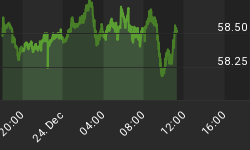The following is part of material that was published for our subscribers February 28 and 29, 2008.
SIGNS OF THE TIMES:
Last Year:
"Greenspan Says Worst of Housing Slowdown is Over"
- Bloomberg, February 14, 2007
"Fed Doesn't See Subprime Mortgages as a Threat"
- Bloomberg, March 1, 2007
* * * * *
This Year:
"Manhattan Immune to Nationwide Housing Crisis"
"For sellers, it's an embarrassment of riches, as in too many rich people looking for ritzy homes. And that demand is pushing prices to record highs."
"Because there is only one Manhattan, and everyone wants a piece of Manhattan."
- This was from a February 20 piece by CBS (New York), which also reported that real estate brokers hadn't "seen this kind of action since the dot.com boom of 2000".
Considering that it is a world of serial bubble-blowing, one can't help but wonder how so many participants get trapped at the top. Yes, the mania in residential housing has had its unique aspects, but the housing market became rather intense along with the impetuous action in crude oil, gold and silver that climaxed in the first part of 1980. Perhaps, there is a generational jump from 28 years ago, but that is not the case in the Manhattan mania, which is only 8 years ago.
Two weeks ago, this section noted that the Manhattan property developer, Harry Macklowe, had failed to refinance a $5.8 billion short-term loan used to buy seven office towers just a year ago in February. This must be a great embarrassment, as Mr. Macklowe was forced to sell properties during the early 1990s real-estate collapse.
Within the package, the "trophy" is the General Motors Building, and as with other premier properties, these have been bid up to the point of very little return via rents. As the head of an advisory firm wryly observed "Nobody ever made money owning the General Motors Building, they only made money selling it".
This reminds of the 1980 boom when speculators out of Tokyo were buying real estate "trophies" around the world. This included the Pebble Beach Golf Club, whereby the last one in overpaid and being over-leveraged got the margin call only six months after his purchase. The loss of $500 million amounted to $28 million per hole.
Be that as it may, the travails of Mr. Macklowe in dealing with Mr. Margin will be worth following. Particularly, as the sub-prime sector took a severe hit this week, which suggests that credit concerns are rumbling around again.
Stock Markets: Despite some wild swings, the stock market continues to act methodically. Which means it seems to be following a pattern we had outlined in November. We had a couple of models that called for a significant decline into January followed by a rebound into March.
The January 24 edition observed that the Nasdaq had suffered a classic 55-day plunge that in most cases when it occurred it marked the end of a great bull market.
The rebound would likely be seen in metals, crude and natgas, as well as in the grains. By March the rebound could be sufficient to make the emergency injections of central-bank credit appear to be successful. Needless to say, but the markets have shown an outstanding recovery in confidence.
However, this has been accomplished as the S&P and Dow are only testing the highs made on the initial rebound out of the January disaster. Technically, rebounds in a bear market can be dramatic and retrace around 50 per cent of the loss, which the two senior indexes accomplished on the initial bounce into early February. The Nasdaq has been relatively weak.
Now the best this rush of confidence is accomplishing is just a test of the last highs. This attempt could run a little further on the daily momentum, but the upside from here is limited in price, and now time.
This week, there was another collapse in sub-prime bonds, and since last May this has been a proxy for calamity in the amazing world of credit innovation. Here we go again.
Selling by traders and investors can become more aggressive.
SUB-PRIME "AAA" BOND
-
The breakdown in May (not shown) preceded the stock market slump into August.
-
The breakdown in early October (shown) anticipated the stock market plunge from October 31 to January 23.
-
This time the AAA Bond took out the previous low of 82.97 on February 8. Now it is at 73.16.
Link to the February 29 "Bob and Phil" show on howestreet.com: http://www.howestreet.com/index.php?pl=/goldradio/index.php/mediaplayer/791
















